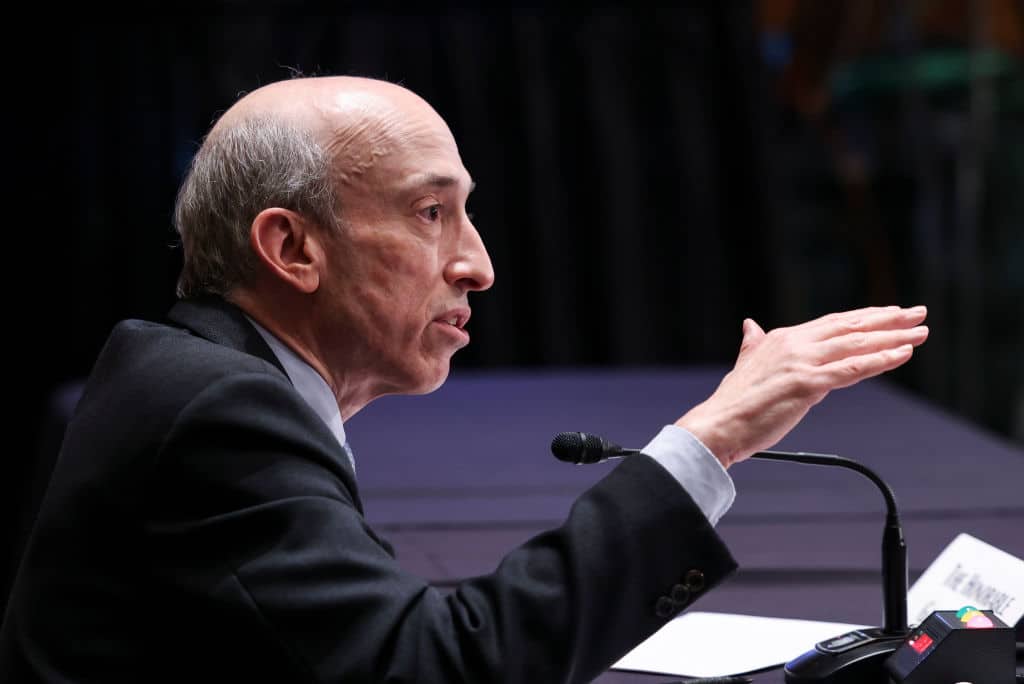In this issue
- Evergrande: No safe house for crypto investors
- Stablecoins: Regulatory reckoning looms
- China’s digital yuan: Racing to the finish line
From the Editor’s Desk
Dear Reader,
Digital currencies frequently draw praise on the grounds that they’re a force for democratizing money. Well, yes and no. As long as democratization is defined narrowly to refer solely to market forces, such claims may enjoy some credibility.
Certainly, if democratization means being tied to markets, the events of the past week may be said to have provided a vivid illustration of “democratic” forces operating flawlessly, with the value of cryptocurrencies slumping amid jitters on traditional financial markets.
The culprit? Hugely indebted Chinese property developer Evergrande, which Beijing appears ready to allow to go to the wall rather than bail out from under its almost US$309 billion of debt. The prospect of this “too big to fail” conglomerate actually failing has roiled financial markets, and the crypto sector has not been immune.
Neither is crypto immune from democracy-defining features other than markets — such as the duty of elected governments to provide their people with frameworks of protective regulation. That much was made clear earlier this week when U.S. Securities and Exchange Commission chief Gary Gensler paved the way for the regulation of stablecoins.
That regulatory reach into monetary matters goes double for China, whose development of a central bank digital currency has proceeded with unmatched speed. Beijing’s authoritarian credentials suggest that many of its uses of e-CNY, as the new currency is known, will be predictable and heavy-handed. What’s harder to foresee, however, are the ways in which China’s new money will change the global monetary system.
What is clear, is that as the U.S. and other democratic countries dither over developing their own digital money, the element of democracy that may be embedded in future global digital currencies may itself be at risk.
Until the next time,
Angie Lau,
Founder and Editor-in-Chief
Forkast.News
1. Crypto investors eye Evergrande’s house of cards

By the numbers: Evergrande — over 5,000% increase in Google search volume.
The potential downfall of massive Chinese property developer Evergrande sent another wave of chills through global financial markets this week. The crypto market was not exempt from the fears stalking investors, suffering a 12.2% plunge in its total market capitalization over the seven-day period up to publishing time. The Fortune 500 firm has almost US$309 billion in debt and its share price is at its lowest point since 2014 — 80% down from July.
- Evergrande’s potential collapse quickly drew comparisons to the failure of Lehman Brothers, which triggered the global financial crisis of the late 2000s. But Beijing may look toward a market-based solution to avoid a domino effect like that triggered by the failure of the U.S. investment bank, Asianmarketsense.com founder Andrew Sullivan told Forkast.News.
- Despite Bitcoin’s brief fall to under US$40,000 on Wednesday morning HKT, Ben Caselin, head of research at crypto exchange AAX, predicts that Bitcoin will push toward new all-time highs before the end of the year.
Forkast.Insights | What does it mean?
Crypto has been regarded — at least by its earliest adopters — as a place for people to put their money when the traditional financial markets have come unstuck. Today, that is no longer the case.
The Evergrande story illustrates this perfectly. The Chinese property developer has spooked not only domestic investors, but international ones, too, and crypto has been caught up in the panic.
Bitcoin’s price slumped to US$40,542 on Tuesday morning Hong Kong time, and projects such as Ethereum followed suit. Others suffered a worse mauling — Polkadot bottomed out 30% down from a high of US$36.96 during the seven-day period and Cardano was trading for under US$1 briefly on Wednesday, the first time it had hit such a low valuation since August. Why? The same people that seek exposure to giant property companies also want exposure to crypto. That means crypto is as tied to global market forces as any other exotic asset.
As crypto seduced retail and institutional investors into betting on blockchain-backed ventures, it effectively bonded digital money to stock markets. When traders saw their portfolios turning bearish, crypto was lumped in with other assets, and a sell-off ensued. The correlation between the S&P 500 and Bitcoin’s price has been growing stronger for the last year.
“We’re at an interesting juncture in traditional markets and crypto markets,” Justin d’Anethan, head of exchange sales at crypto exchange EQONEX told Forkast.News. “There are positives and negatives, but for now, investors are giving in to bearishness across the board.”
As the price of gold — a traditional safe haven — has been rising steadily, Bitcoin — crypto’s answer to the precious metal — has gone the other way. What does this mean? Crypto, and with it its rebel image, appears to be fast becoming just another plaything for the 1%.
2. SEC to stablecoins: the party’s over

By the numbers: Stablecoins — over 5,000% increase in Google search volume.
U.S. Securities and Exchange Commission Chair Gary Gensler this week compared stablecoins to poker chips, and in an interview called for stronger crypto regulations. His remarks followed a letter from a group of investors requesting that the SEC regulate stablecoins with increased scrutiny and clarity. The letter, signed by the Americans for Financial Reform Education Fund, the Consumer Federation of America and others, singled out stablecoins, crypto lending and crypto exchanges as deserving of greater SEC attention.
- The SEC has taken multiple actions to scrutinize stablecoins and crypto lending businesses. Gensler made extensive comments on regulating the crypto market during a Senate hearing last Tuesday, saying that stablecoins “may well be securities” and that crypto staking and lending services were likely to fall under the SEC’s jurisdiction.
- Coinbase, in particular, appeared to be on a collision course with the regulator, last Friday abandoning Coinbase Lend — a planned platform that was to pay users interest for lending USD Coin to Coinbase — after receiving warnings from the SEC that it intended to sue the company if it launched the platform.
- The New York Times published an explainer article on stablecoins and potential options for regulating the sector, saying that the rush to bring stablecoins under regulatory control might be “the most important conversation in Washington financial circles this year.”
Forkast.Insights | What does it mean?
Regulation has the unenviable status of a dirty word among some in cryptocurrency circles — the assumption being that regulators’ natural inclination is to strangle the rapid pace of innovation that has seen trillions of dollars pour into blockchain backed projects. But regulation should be welcomed.
When it’s executed properly, oversight prevents bad actors from selling digital snake oil to unsuspecting consumers. If and when things go wrong, it also provides a legal framework to apportion culpability. Tether is a prime example.
The issuer of USDT, the world’s biggest stablecoin, has struggled to convince regulators that the US$90 billion of its tokens in circulation is backed dollar for dollar, as it promised it would be. New York State has banned its use and the SEC has warned that a full investigation is imminent. The upcoming probe is a positive and necessary development.
If Tether isn’t operating as it should — and there has been a lot of evidence suggesting that it isn’t — its position as a safe haven for twitchy Bitcoin investors could mean that a default, or a bug, or a hack may lead to a collapse. That would be disastrous for crypto, and also for broader financial markets.
If Washington regulates stablecoins, it will provide a trustworthy on-ramp for millions of consumers to move beyond paper money and into the Web 3.0 world. In a quid pro quo for acceptance and official recognition, stablecoin issuers and other crypto operators will have to clean up their act and learn to play by the rules.
3. China’s digital yuan sprints to finish line

As predictions abound that China’s state digital currency will be fully rolled out in time for the Winter Olympics in Beijing next February, the country’s central bank says the digital yuan pilot program for the upcoming games is already approaching the finish line. Fan Yifei, a deputy governor of the People’s Bank of China, says infrastructure construction for the use of e-CNY, as the new currency is known, during the Olympics has entered a “sprint stage,” according to the central bank.
- Fan made the comments during a visit to Olympics venues in Beijing and Zhangjiakou, a city in northern China’s Hebei Province, during which he reviewed progress on e-CNY payment tests.
- China has also been no slouch when it comes to pushing ahead with the overseas expansion of its blockchain infrastructure initiative. In a soft launch, blockchain developers in Hong Kong and Macau are now able to obtain access to the portal of China’s Blockchain-based Service Network (BSN) — a public-private nationwide infrastructure project designed to foster mass adoption of blockchain technology — as BSN continues to fuel its expansion abroad.
- Earlier this month, Red Date, a company Beijing tapped to manage BSN, announced a partnership in South Korea with blockchain business MetaverseSociety, which will be the exclusive operator of a BSN portal in the country that is expected to launch in November.
Forkast.Insights | What does it mean?
Although the past week’s headlines have been dominated by Aukus — a security pact between the U.S, the U.K. and Australia forged to counter China’s growing military aggression, particularly in the Indo-Pacific — the world’s most populous country has been increasing its digital heft with no such pushback.
The U.S. may have asked its allies to keep a closer eye on China’s military, but it appears to have done almost nothing when it comes to blockchain and Beijing’s rollout of its new digital currency.
As the Americans have dawdled over what to do about digital currencies, Chinese innovation in the blockchain space has been moving at a brisk pace. The People’s Bank of China alone has filed more than 80 patents related to digital currencies.
“There is a new space race,” wrote Perianne Boring, president of the U.S.-based Chamber of Digital Commerce. “It is the cyberspace race of building and controlling the systems and governance that will power the digital economy.”
Beijing’s ambitions for its digital currency — beyond giving it direct access to piles of data on people’s spending habits — include eventually challenging the U.S. dollar’s preeminent position as the world’s reserve currency.
“China’s rapid development of a central bank digital currency has the potential to upset the global monetary order,” the editorial board of the Financial Times wrote last month.
The FT went on to suggest that the yuan could “bypass rival Western-operated cross-border payment networks, such as Swift, which the U.S. has used to enforce sanctions.”
The announcement that China is inviting neighboring countries to be part of its digital currency rollout is the first step on that journey.
Some have called e-CNY crypto’s Sputnik moment, a reference to the Soviet Union’s early lead in the space race that galvanized U.S. policymakers to throw hundreds of billions of dollars at their own space program. Can America catch up or will it be left behind?




